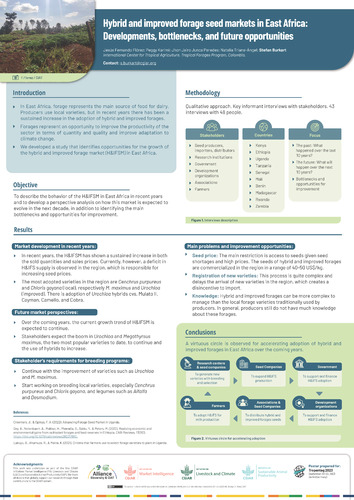Hybrid and improved forage seed markets in East Africa: Developments, bottlenecks, and future opportunities
In East Africa, forages are the main feed source for dairy cattle. Producers use local varieties but in recent years there has been a sustained increase in the adoption of improved forage varieties and hybrids aimed at increasing productivity and improving adaptation to climate change. However, little is known yet about the forage seed market and how it can be improved to further boost the adoption of improved materials. The objective of this research is to describe the behaviour of the seed market for improved forage varieties and hybrids in East Africa in recent years and to develop a perspective analysis on how this market is expected to evolve over the next decade, in addition to identifying the main bottlenecks and opportunities for improvement. We applied a qualitative approach based on semi-structured interviews with stakeholders from the forage value chain in 10 East African countries. Our research covered three pillars, namely i) the past: how did the forage market evolve over the last ten years, ii) the future: how could the market evolve over the next ten years, and iii) bottlenecks and opportunities for improvement. A total of 46 key informant interviews were carried out. We found a virtuous circle that could facilitate the acceleration of the adoption of (hybrid) forages in East Africa. Research centres want to continue their breeding and seed selection programmes to improve existing varieties and bring new varieties on the market. Seed companies are interested in increasing their supply of seeds both in terms of quantities and diversification of varieties. Governments and development organisations express their interest in continuing to support and finance the promotion and adoption of (hybrid) forages. Producer associations plan alliances with seed companies to distribute seeds among their producers at more affordable prices. Finally, dairy farmers are interested in (hybrid) forages to increase milk production, maximise the space used for cattle farming, and reduce their vulnerability to climate change.

